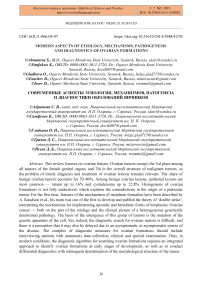Modern aspects of etiology, mechanisms, pathogenesis and diagnostics of ovarian formations
Автор: Abramova Svetlana, Simfukwe Keith, Gladkova Olga, Grachev Dmitrii, Iseev Dmitrii
Журнал: Бюллетень науки и практики @bulletennauki
Рубрика: Медицинские науки
Статья в выпуске: 5 т.5, 2019 года.
Бесплатный доступ
This review focuses on ovarian lesions. Ovarian tumors occupy the 3rd place among all tumors of the female genital organs, and 7th in the overall structure of malignant tumors, so the problem of timely diagnosis and treatment of ovarian lesions remains relevant. The share of benign ovarian tumors accounts for 70-80%. Among benign ovarian lesions, epithelial lesions are most common - tatami up to 16% and cystadenoma up to 22.8%. Histogenesis of ovarian formations is not fully understood, which explains the contradictions in the origin of a particular tumor. For the first time, features of the mechanisms of neoplasm formation have been described by A. Knudson et al., his team was one of the first to develop and publish the theory of ‘double strike’, interpreting the mechanisms for implementing sporadic and hereditary forms of neoplasms. Ovarian cancer - both on the part of the etiology and the clinical picture of a heterogeneous genetically determined pathology. The basis of the emergence of this group of tumors is the mutation of the genetic apparatus of the cell...
Ovarian formation, etiology, pathogenesis, mechanisms, diagnosis
Короткий адрес: https://sciup.org/14115868
IDR: 14115868 | УДК: 618.11-006.04-07 | DOI: 10.33619/2414-2948/42/05
Список литературы Modern aspects of etiology, mechanisms, pathogenesis and diagnostics of ovarian formations
- Agrinier N., Cournot M., Dallongeville J. Menopause and modifiable coronary heart disease risk factors: A population based study // Maturitas. 2010. V. 65. №3. P. 237-243.
- Stewart B.W., Wild С.Р. World cancer report. Lyon // IARC. 2014. 916 p.
- Colombo N., Peiretti M., Garbi A. Non-Epithelial Ovarian Cancer: ESMO Clinical Practice Guidelines for diagnosis, treatment and follow-up // Ann Oncol. 2012. V. 23. №7. Р. 20-26.
- Randall L. M. et al. Multi-disciplinary summit on genetics services for women with gynecologic cancers: A Society of Gynecologic oncology White Paper // Gynecologic oncology. 2017. V. 146. №2. P. 217-224. DOI: 10.1016/j.ygyno.2017.06.002
- Stiekema A., Boldingh Q. J., Korse C. M. Serum human epididymal protein 4 (HE4) as biomarker for the differentiation between epithelial ovarian cancer and ovarian metastases of gastrointestinal origin // Gynecologic oncology. 2015. V. 136. №3. P. 562-566. DOI: 10.1016/j.ygyno.2014.12.037
- Santotoribio J. D. et al. Cancer antigens 19.9 and 125 as tumor markers in patients with mucinous ovarian tumors // Eur J Gynaecol Oncol. 2016. V. 37. №1. P. 26-9.
- DOI: 10.12892/ejgo2758.2016
- Fagotti A. et al. Current recommendations for minimally invasive surgical staging in ovarian cancer // Current treatment options in oncology. 2016. V. 17. №1. P. 3.
- DOI: 10.1007/s11864-015-0379-8
- Morgan R. J. et al. Ovarian cancer, version 1.2016, NCCN clinical practice guidelines in oncology // Journal of the National Comprehensive Cancer Network. 2016. V. 14. №9. P. 1134-1163.
- DOI: 10.6004/jnccn.2016.0122
- Fotopoulou C. et al. British Gynaecological Cancer Society (BGCS) epithelial ovarian/fallopian tube/primary peritoneal cancer guidelines: recommendations for practice // European Journal of Obstetrics & Gynecology and Reproductive Biology. 2017. V. 213. P. 123-139.
- Grossman D. C. et al. Screening for ovarian cancer: US preventive services task force recommendation statement // Jama. 2018. V. 319. №6. P. 588-594.
- DOI: 10.1001/jama.2017.21926
- Luo Z. et al. Tumor microenvironment: the culprit for ovarian cancer metastasis? // Cancer letters. 2016. V. 377. №2. P. 174-182.
- DOI: 10.1016/j.canlet.2016.04.038


